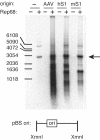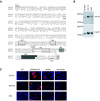Characterization of the mouse adeno-associated virus AAVS1 ortholog
- PMID: 15280500
- PMCID: PMC479059
- DOI: 10.1128/JVI.78.16.8917-8921.2004
Characterization of the mouse adeno-associated virus AAVS1 ortholog
Abstract
The nonpathogenic human adeno-associated virus (AAV) has developed a mechanism to integrate its genome into human chromosome 19 at 19q13.4 (termed AAVS1), thereby establishing latency. Here, we provide evidence that the chromosomal signals required for site-specific integration are conserved in the mouse genome proximal to the recently identified Mbs85 gene. These sequence motifs can be specifically nicked by the viral Rep protein required for the initiation of site-specific AAV DNA integration. Furthermore, these signals can serve as a minimal origin for Rep-dependent DNA replication. In addition, we isolated the mouse Mbs85 proximal promoter and show transcriptional activity in three mouse cell lines.
Figures




Similar articles
-
A 16bp Rep binding element is sufficient for mediating Rep-dependent integration into AAVS1.J Mol Biol. 2006 Apr 21;358(1):38-45. doi: 10.1016/j.jmb.2006.01.029. Epub 2006 Jan 30. J Mol Biol. 2006. PMID: 16516232
-
Transcriptional analysis of the adeno-associated virus integration site.J Virol. 2009 Dec;83(23):12512-25. doi: 10.1128/JVI.01754-09. Epub 2009 Sep 16. J Virol. 2009. PMID: 19759129 Free PMC article.
-
Adeno-associated virus site-specific integration and AAVS1 disruption.J Virol. 2004 Aug;78(15):7874-82. doi: 10.1128/JVI.78.15.7874-7882.2004. J Virol. 2004. PMID: 15254160 Free PMC article.
-
Site-specific integration by adeno-associated virus.Proc Natl Acad Sci U S A. 1996 Oct 15;93(21):11288-94. doi: 10.1073/pnas.93.21.11288. Proc Natl Acad Sci U S A. 1996. PMID: 8876128 Free PMC article. Review.
-
Site-specific integration by the adeno-associated virus rep protein.Curr Gene Ther. 2011 Oct;11(5):399-405. doi: 10.2174/156652311797415809. Curr Gene Ther. 2011. PMID: 21827397 Review.
Cited by
-
Site-specific integration of adeno-associated virus involves partial duplication of the target locus.Proc Natl Acad Sci U S A. 2009 May 5;106(18):7571-6. doi: 10.1073/pnas.0806821106. Epub 2009 Apr 16. Proc Natl Acad Sci U S A. 2009. PMID: 19372372 Free PMC article.
-
Targeting site-specific chromosome integration.Acta Biochim Pol. 2005;52(2):285-91. Epub 2005 Jun 3. Acta Biochim Pol. 2005. PMID: 15940345 Free PMC article. Review.
-
Myosin phosphatase is inactivated by caspase-3 cleavage and phosphorylation of myosin phosphatase targeting subunit 1 during apoptosis.Mol Biol Cell. 2013 Mar;24(6):748-56. doi: 10.1091/mbc.E11-08-0740. Epub 2013 Jan 23. Mol Biol Cell. 2013. PMID: 23345589 Free PMC article.
-
Substitution of adeno-associated virus Rep protein binding and nicking sites with human chromosome 19 sequences.Virol J. 2010 Sep 8;7:218. doi: 10.1186/1743-422X-7-218. Virol J. 2010. PMID: 20825662 Free PMC article.
-
Adeno-associated virus: a key to the human genome?Future Virol. 2010 Sep 1;5(5):555-574. doi: 10.2217/fvl.10.48. Future Virol. 2010. PMID: 21212830 Free PMC article.
References
-
- Amiss, T. J., and R. J. Samulski. 2001. Methods for adeno-associated virus-mediated gene transfer into muscle. Methods Mol. Biol. 175:455-469. - PubMed
-
- Bakowska, J. C., M. V. Di Maria, S. M. Camp, Y. Wang, P. D. Allen, and X. O. Breakefield. 2003. Targeted transgene integration into transgenic mouse fibroblasts carrying the full-length human AAVS1 locus mediated by HSV/AAV rep(+) hybrid amplicon vector. Gene Ther. 10:1691-1702. - PubMed
-
- Berns, K. I. 1996. Parvoviridae: the viruses and their replication, p. 2173-2197. In B. N. Fields, D. M. Knipe, and P. M. Howley (ed.), Fields virology, 3rd ed., vol. 2. Lippincott-Raven, Philadelphia, Pa.
Publication types
MeSH terms
Substances
Grants and funding
LinkOut - more resources
Full Text Sources
Other Literature Sources
Molecular Biology Databases

